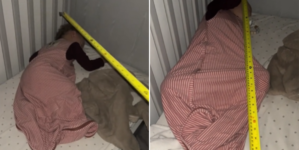-
Utter devastation as Mountain fire levels hillside neighborhoods - 10 mins ago
-
Woman Stays at Apartment by Arena—Bags ‘Once-in-a-Lifetime Experience’ - 14 mins ago
-
Powell, Fed Chair, Will Likely Face Heavy Pressure From Trump - 38 mins ago
-
Marcos Signs Laws Rejecting China’s Expansive Sea Boundary Claims - 49 mins ago
-
After Trump win, next LAPD chief’s immigration record under scrutiny - 51 mins ago
-
Hungary’s Viktor Orban and European Far-Right Leaders Welcome Trump’s Return - about 1 hour ago
-
Toddler Mom Makes Horror Realization Night Before Family Outing: ‘Forgot’ - about 1 hour ago
-
For transgender Americans, Trump’s win is terrifying - 2 hours ago
-
Temple of Satan Seeks Legal Recognition - 2 hours ago
-
How Democrats Made It Easy for Trump - 2 hours ago
Large Viking Burial Ground With 139 Graves Revealed
Archaeologists have uncovered a huge Viking burial ground featuring more than a hundred graves, including some shaped like ships.
The burial ground came to light during investigations of an earlier Stone Age settlement in the locality of Tvååker, Varberg Municipality, in southern Sweden, Arkeologerna (The Archaeologists), the country’s leading consultancy on archaeology and cultural environments, said in a press release.
It is dated to the Viking Age, a period in medieval history roughly between the late 8th and 11th centuries when seafaring Norse people from Scandinavia, commonly referred to as Vikings, raided, colonized, explored and traded widely across Europe and far beyond.
In total, archaeologists have identified 139 cremation graves at the burial ground so far, although it is possible that the site is significantly larger.

Arkeologerna, SHM
“We have calculated that we have only excavated six percent of the burial ground,” Petra Nordin, project manager at Arkeologerna, part of the National Historical Museums, told Newsweek.
Intriguingly, archaeologists have also identified several ship-style graves at the burial ground. These include three “ship-shaped stone settings” and a ship-shaped mound.
Ship-shaped stone settings, also referred to as stone ships or ship burials, are a type of grave marker or ceremonial structure from the Viking Age and earlier, seen in Scandinavia and other parts of Northern Europe.
These arrangements consist of large stones placed on the ground in the outline of a ship, sometimes extending up to tens or hundreds of feet in length. They were used primarily as burial monuments or memorials and symbolized the journey to the afterlife, given that ships were considered vessels for transporting the dead into the next world.
These stone “ships” vary in size and detail, ranging from simple arrangements with a few stones to elaborate settings with multiple rows of stones. Archaeologists have found that some stone ships contain cremated remains or artifacts.
The largest of the ship-shaped stone setting graves identified at the Tvååker site measures more than 160 feet in length, according to Nordin.
Ship-shaped mounds from the Viking Age are burial mounds constructed in the shape of a ship, often using earth and stones. In some cases, these mounds contain the remains of real ships that were ritually burned.
One of the graves at the burial ground, appears to contain evidence of such a practice. In grave 68, a burning of a ship probably took place on a “stone packing” that was around 50 feet in length, Nordin said. In archaeology, stone packing refers to stones placed around or beneath an object, structure, or feature to provide stability, protection, or support.
Archaeologists found human remains in almost 85 percent of the graves, according to Nordin. The deceased who are buried at the site would likely have been burnt on funeral pyres. But researchers also uncovered a variety of other remains, including animal bones, jewelry and pottery.
Most of the objects found were heavily affected by fire. Among the most intriguing finds was an Arab silver coin dated to between A.D. 795 and 806, a range which agrees well with the oldest graves at the site.
The animal bones discovered included those of dogs, birds, cattle and pigs, although in many cases it has not been possible to classify them.
“After the dead were burned, unburned animals were placed on top, before the graves were finally closed,” Nordin said in the press release.
Where the people who were buried at the site lived is still something of a mystery. There was probably a village in the Tvååker area that expanded heavily during the early Viking Age. But such a settlement has yet to be identified.
“It is exciting to see what will emerge in the future,” Nordin said in the press release.
Do you have a tip on a science story that Newsweek should be covering? Do you have a question about archaeology? Let us know via science@newsweek.com.
Source link


















